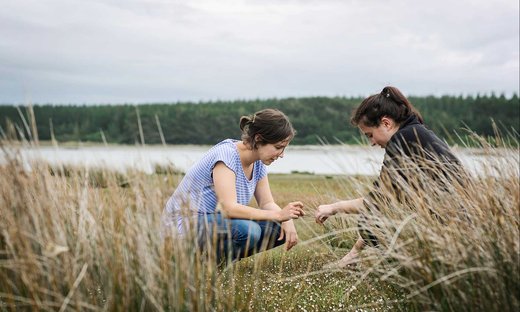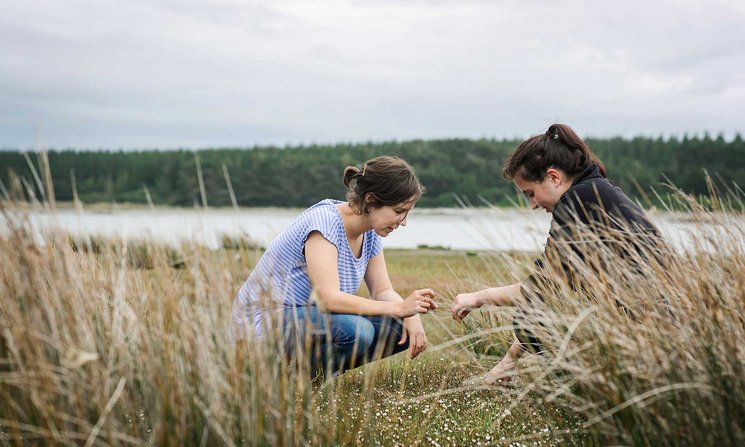On this page
- Sustainable commuting and travelling initiatives
- Sustainability – a key focus for new buildings
- Recording and preserving cultural heritage
- International collaborations and impact
- Green Impact programme launched
- Campuses for our communities
- Supporting and showcasing local arts
- Preserving heritage through smart development
- Advancing research on natural disasters
- Distinguished Professors in disaster management
- Advancing sustainable transport through research
- New sustainable cities guide
- Social housing exhibition
- Disaster experiences in Ōtautahi Christchurch: lessons and perspectives
- Green Impact Labs Accreditation
- Invercargill Initiative wins Social Impact award
- Related content

Sustainable commuting and travelling initiatives
Massey University’s Carbon Action Plan includes targets for more sustainable commuting and travelling, including a 30% reduction in land transport-related emissions and increasing EVs in the fleet to 90% of the total by 2030.
To help meet these targets, Massey published guidelines for low-carbon travel in 2022.
In September 2023, the Sustainability office commuting survey found that 74% of staff and student respondents use buses for most or all of their commutes to and from campus, with 94% using buses for at least half of their trips. When they’re not commuting by bus:
- 38% travel in a shared vehicle
- 18% run or walk
- 18% cycle or e-scooter
- 44% think they could commute by bus more often.
Massey staff and students using a Horizons Bee card can use buses for free within Palmerston North City and travel to and from campus.
On the Wellington campus, electric bicycles can be borrowed for free by students and staff.
Aotearoa Collective for Public Transport Equity
Massey pledged its support for the Aotearoa Collective for Public Transport Equity in 2022. The Collective is a group of around 60 organisations that have joined forces to seek free public transport for tertiary students, Community Services Card holders and under 25s.
Massey voices its support for free public transport for students
Sustainability – a key focus for new buildings
Massey has committed that all new buildings achieve the '5 Green Star New Zealand Excellence' rating in the 'Green Star' building standard or the equivalent. This standard is a sustainability rating system certified by the Green Building Council Australia.
The newly built Veterinary school Student Learning Complex and Post-Mortem/Production Animal Hospital facility incorporate numerous sustainability features in their design.
- Insulation-enhanced walk-in chillers and freezers.
- Lab areas linked with the Campus Building Management system, which allows remote control of building systems and setting time schedules.
- LED lighting with intelligent control systems to reduce lighting when not required.
- Specialised lab equipment, including speed-adjustable fans, increases energy efficiency.
- Modular lab joinery minimises material wastage and allows for future adaptability.
- Passive ventilation and motorised dampers shut down ventilation in unoccupied spaces.
- Use of long-lasting, low-maintenance materials. For example, brickwork along University Avenue and glazing in some areas absorb UV light, protecting equipment and building materials.
- Heat recovery units and carbon dioxide sensors reduce heating and cooling costs.
- Sensor taps throughout the buildings reduce water wastage.
Massey's sustainable building practices
Massey is committed to promoting sustainable building practices on campus and in our construction qualifications. This video explains more about the green features within some of our new buildings and what our built environment researchers are exploring to improve the sustainability of buildings of the future.
Recording and preserving cultural heritage
Massey delivers many projects to record and preserve intangible cultural heritage. Examples include:
- Ngā Kupu Ora collections. These collections with significant Māori content include books, journals, newspapers, audiovisual material and images. The collections are in the Auckland and Manawatū campus libraries.
- Massey's School of Māori Knowledge, Te Pūtahi-a-Toi, seeks to retain and develop New Zealand's heritage and contribute to the advancement of Indigenous Peoples.
- The Bagnall Collection, which is a collection of rare and significant material relating to New Zealand and the Pacific.
- The university's many qualifications preserve Māori knowledge. For example, the Bachelor of Māori Visual Arts is a degree dedicated to recording, preserving and nurturing Māori art and traditions.
- The university's growing art collection, which focuses on contemporary New Zealand artists — strengthened in recent years by the acquisition of contemporary Māori work.
Furthermore, Massey was instrumental in the development of The Proverb Pathway, launched in 2021. A unique community project in Palmerston North featuring an outdoor staircase engraved with proverbs from many diverse languages and cultures. This Welcoming Communities initiative is preserving the culture of both our local communities and displaced ones.
International collaborations and impact
Over half, 58%, of Massey University’s 353 SDG11 publications between 2020 and 2024 resulted from international collaborations (Scopus database extracted using SciVal in October 2025).
The publications were predominantly in the subject areas of social sciences and environmental sciences, with a significant emphasis on research related to geoheritage, geodiversity, disaster and emergency management and community resilience.
Green Impact programme launched
Massey launched the Green Impact programme in 2023, a United Nations award-winning programme, to empower staff and students to take practical action on everyday sustainability challenges. In 2023, 11 teams across all three campuses completed 250 sustainability actions, from reducing waste to improving energy efficiency.
In 2024, the programme grew to 13 teams, who carried out over 528 individual actions. These ranged from stocking reusable crockery to native planting projects and waste reduction initiatives.
Green Impact continues to build a culture of sustainability across Massey’s campuses, one action at a time.
Campuses for our communities
The public are welcome to enjoy Massey University’s beautiful campuses year-round. Our grounds are open and free to explore, offering a mix of art, heritage and nature.
Visitors can discover the Massey University Art Collection, displayed throughout public spaces across our 3 campuses and in the Auckland campus library. This includes Massey’s collection of outdoor sculptures and monuments, including Binary in Manawatū, The Golden Promise in Auckland and Poutaha in Wellington which were created to celebrate the University’s golden jubilee.
The public are welcome to view our historic buildings, including the Refectory and the iconic Sir Geoffrey Peren Building. Occasional guided tours are also offered with prior arrangement. These buildings surround the historic “Oval”, an open green space which for nearly 100 years has been cherished for garden parties, cricket and other sporting events. It has been likened to a village green. In 2024, the Oval and its surrounding historically significant buildings — collectively known as the “Turitea Historic Area” — were added to New Zealand’s Heritage List, reflecting the high cultural significance of this area.
Visitors are welcome to attend a wide range of public events and lectures held across our campuses. Art lovers can also attend our many exhibitions, including the annual Exposure showcase and regular displays at the Engine Room gallery.
Our gardens, including the renowned and historic Wharerata Gardens on the Manawatū campus, provide a tranquil escape among roses, rhododendrons, camellias and formal lawns. Parts of these gardens date back more than a century and are lovingly maintained by expert horticulturalists.
The public are also welcome to use our libraries and the Massey University Archives, with free access to reading spaces and book use in library, and guest Wi-Fi.
Find out more about the Turitea Historic area
Learn about the Massey University Art Collection
Kōtuia details about the Massey University Art Collection
Find out more about using the library as a visitor
Find out more about upcoming events for students, staff and the public
Supporting and showcasing local arts
Massey University staff and students actively contribute to the local arts scene through a range of performances and exhibitions.
Showcase 2025
Open to all, this performance featured cinepoems, music videos, and a standout project addressing food waste through creative storytelling. It celebrated work by Digital Media Production and Creativity in the Community students.
Off the Page
A writers’ series which features authors reading from their work, talks, discussions, workshops, and more. Off the Page National Poetry Day was a special evening of poetry and conversation and a highlight on the 2025 calendar. Events are held at the Palmerston North City Library.
Exposure He Kanohi Kitea
An annual exhibition of final-year work from Toi Rauwhārangi College of Creative Arts, featuring design, fine arts, screen arts, photography and commercial music.
Manawatū Summer Shakespeare
Massey staff proudly support this annual event with technical assistance, rehearsal spaces, costumes, props and other event support.
Creativity in the Community
An annual free public performance which showcases a range of creative works, co-hosted with a local partner (2025 partner Everybody Eats, 2024 Women’s Refuge).
Read more about Creativity in the Community events
Climate Change Theatre Action
A climate play reading event in Wellington in December 2025. This includes a return performance of the renowned The Penguins play.
Read more about Climate Change Theatre Action
CubaDupa
Massey student bands regularly perform at this vibrant Wellington festival of music, street theatre, and art installations.
Matatau 2024
A powerful exhibition of graduating Māori Visual Arts students exploring Mana Tangata through performance, sculpture, painting and photography. Held at Te Manawa museum in Palmerston North.
print on site 2024
A public exhibition in October 2024 which showcased textile and ceramic tile designs, exploring Wellington’s urban environment through drawing, walking, pattern‐making and printing.
Te Rākau Hua o Te Wao Tapu Theatre Company in Residence
The theatre company features regular public showings and open rehearsals. Recent works include Unreel (2024), Waenga (2025), and Out the Gate (2025).
Preserving heritage through smart development
Massey University prefers to refurbish and repurpose existing buildings and to develop new facilities on brownfield sites wherever possible. By prioritising brownfield development, Massey balances heritage preservation with modern, sustainable campus growth.
A prime example is the historic Refectory Building, originally built in 1930, which has recently been carefully restored and strengthened, transforming a long-vacant space into the University’s headquarters. Originally the dining hall and social hub for students, and later used as a teaching facility, the Refectory’s revival preserves its heritage while adapting it for modern needs.
Another example is the University’s new Vet School, where the Post Mortem and Anatomy building occupies the footprint of its predecessor, allowing continuity of purpose while incorporating state-of-the-art design.
Find out more about the restoration of our Refectory building
Advancing research on natural disasters
Advancing research on natural disasters
Between 2022 and 2024, Massey researchers have secured major funding to advance critical research aimed at reducing disaster risk and improving community safety.
In 2022, several Massey-led projects received support for innovative disaster research. Dr. Ruggiero Lovreglio was awarded a Rutherford Discovery Fellowship to improve evacuation planning and reduce loss of life during emergencies. MBIE Endeavour Funding of nearly $1 million supported groundbreaking work on predicting volcanic eruptions, while a Toka Tū Ake EQC Biennial Grant funded research into how best to communicate volcanic risk. Another project, co-funded by Massey and EQC, brought together global experts to develop a new earthquake early-warning system.
By 2024, Massey academics continued to make significant strides in mitigating the impacts of natural hazards, earning prestigious fellowships and funding from MBIE, Tāwhia te Mana, and the National Institute of Standards and Technology.
Massey has also led a range of public engagement initiatives to raise awareness and strengthen community resilience. Highlights included the Active Land talk series at Te Papa, an interactive tsunami exhibition and the CRISiSLab Challenge, where students showcased their tsunami alert system designs.
Distinguished Professors in disaster management
Distinguished Professors in disaster management
In 2024, recognised leaders in disaster management Professors David Johnston and Christine Kenney were appointed Distinguished Professors. This honour acknowledges their outstanding contributions to reducing the impacts of climate change and natural disasters — including earthquakes — on communities in Aotearoa New Zealand and around the world.
Advancing sustainable transport through research
Advancing sustainable transport through research
In 2024, a Master of Resource and Environmental Planning student received a Transport Research Scholarship to investigate why women shift from low-carbon transport abroad to private vehicles in New Zealand. The research aims to inform more effective and sustainable transport policies.
New sustainable cities guide
New sustainable cities guide
Massey University academics have co-authored Transitions in Action: An Urban and Regional Guide for Te Upoko o te Ika Wellington. It is focused on what a just, climate-resilient and flourishing future for Wellington looks like and how we get there. The free guidebook showcases more than 30 grassroots initiatives — such as car-sharing, co-housing and urban vegetable growing — that are already reshaping the capital. Rooted in te ao Māori, the guide highlights 6 key areas — transport, community, economy, energy, environment and housing — to inspire climate-resilient and equitable futures.
Social housing exhibition
Social housing exhibition
Massey collaborated with over 30 Wellington social housing tenants to showcase their lives through written stories, artworks and photographs. The outdoor exhibition, which opened in February 2023, presents a counter-narrative to the often negative stereotype of social housing.
Disaster experiences in Ōtautahi Christchurch: lessons and perspectives
Disaster experiences in Ōtautahi Christchurch: lessons and perspectives
Published in 2022, A Decade of Disaster Experiences in Ōtautahi Christchurch: Critical Disaster Studies Perspectives was co-edited by Massey’s Professor Bruce Glavovic.
The book reveals important lessons from real-world experiences of living through major events – including earthquakes, floods, the COVID-19 pandemic, a terrorist attack and the impacts of climate change.
Green Impact Labs Accreditation
Green Impact Labs Accreditation
The MEpi Legends Green Impact Team are among the first in the world to take part in the new Green Impact Labs Accreditation (GILA-ANZ).
After starting in Massey’s regular Green Impact programme, the team advanced to this lab-focused accreditation in their second year. They are on track to achieve full accreditation by the end of 2025, formally recognising their commitment to environmentally responsible research in wet labs.
Invercargill Initiative wins Social Impact award
Invercargill Initiative wins Social Impact award
The Invercargill Initiative – Creating a Bright Future with Invercargill’s Young People, won an award in the Social Impact category of the Australian Good Design 2022 Awards in recognition of outstanding design and innovation. The aim of the initiative was to make meaningful differences in the lives of young people experiencing exclusion and disadvantage in Invercargill.








